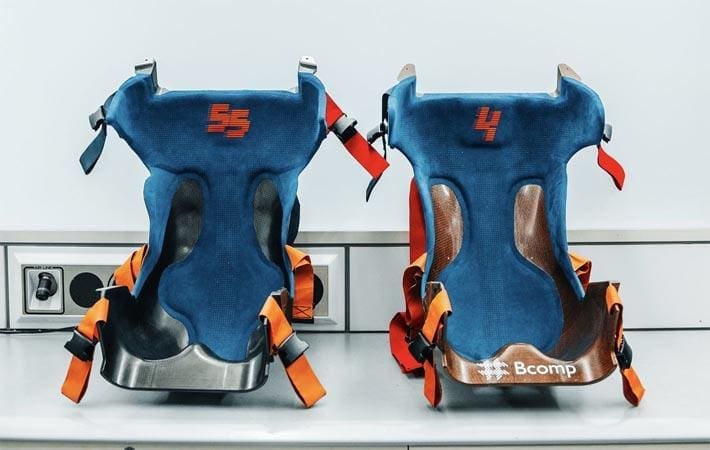McLaren has collaborated with Swiss sustainable lightweighting specialist Bcomp to develop F1’s first natural fibre composite racing seat for Carlos Sainz and Lando Norris. This is the first F1 car part to be made of renewable textile fibres. The seat has been created by optimising the mechanical properties of flax fibres through fabric architecture.
The result is a seat with the required strength and stiffness, but with a 75 per cent lower carbon dioxide footprint compared to its carbon fibre counterpart.
“The use of natural fibre composites is the latest example of pioneering, composite materials innovation at McLaren,” explains McLaren F1 team principal Andreas Seidl. “Not only does this solution provide equivalent performance to carbon fibre, it represents another step forward in our evolving sustainability programme, while underlining our commitment to helping F1 turn its ambitious sustainability strategy into action.”
“For decades, F1 has been an innovation lab for technology that has transformed not just motorsport, but the automotive industry and beyond,” adds McLaren F1 technical director James Key. “The sport must continue down the road of getting to an increasingly environmentally friendly set of conditions, and our development and application of natural fibre composites is an example of how we’re accelerating this journey, as well as the ongoing evolution towards cleaner mobility.”
Bcomp CEO and co-founder Christian Fischer, says: “Sustainability and decarbonisation is a global issue, and it is fantastic to see motorsport embrace carbon alternatives, paving the way for widespread adoption within large-scale mobility applications. McLaren has always been a pioneer within the sport, in terms of both composites and sustainability, thus it feels like the perfect match and a great honour to collaborate with such a prestigious brand.”
Primarily used in the production of linen, flax is a versatile plant. It differs from many biomaterials in that it’s ideal for use in crop rotation programmes and can be grown without directly competing with food crops. Flax is a CO2-neutral raw material and its fibres are biodegradable. At the end of the seat’s life, for example, it can be ground down into a new base material or thermally recycled without residual waste, rather than end up in landfill.
Inspired by the thin veins on the back of leaves, Bcomp’s proprietary powerRibs technology provides a three-dimensional grid structure on one side of the seat, which is then used to reinforce Bcomp’s optimally spun and woven flax fibre reinforcement fabric, ampliTex. Made by twisting flax fibres to form a thick yarn, the powerRibs act as a backbone to the ampliTex flax fabric that is bonded to it.
The technology was used in the car seat in view of the current F1 technical regulations. Since 2019, a minimum driver weight of 80 kilogram has been mandated. And if a driver weighs less than that, ballast must be used to bring them up to the minimum weight. But instead of allowing this ballast to be placed in other areas of the car, which could improve weight distribution, it must be located within the immediate area of the driver’s seat.
“With the introduction of the new regulation in 2019, the seat now forms part of the driver’s weight budget, so it’s overengineered as a result,” explains McLaren F1 principal composites engineer Steve Foster. “And with Carlos and Lando weighing in at 72 kilograms and 68 kilograms respectively, there’s plenty of scope to do that. It meant that, if we needed to, there was margin to use additional bio-composite material to ensure sufficient strength and stiffness in this safety-critical component.”
“The original carbon fibre seat design was reverse-engineered by Bcomp, and then we optimised and manufactured the new design. The seat was run in pre-season testing without any problems and we hope to be racing with Bcomp flax seats in the near future,” Foster adds.
“We believe this seat functions as a conclusive demonstration that our technologies are ready to compete in the top tier of motorsport,” adds Fischer. “We match conventional carbon fibre while lowering the eco footprint by 75 per cent, cutting costs, reducing vibrations and improving safety – all of which are highly relevant to achieving a sustainable future for motorsport and mobility.”
Since the inaugural round of the FIA Formula One World Championship in 1950, the pinnacle of motorsport has seen teams relentlessly push the boundaries of technology in pursuit of performance, making it the birthplace for countless ingenious innovations. But if there’s one pioneering breakthrough that has captured the imagination most, transforming the sport and beyond, it would have to be the introduction of the first car with a carbon fibre monocoque chassis, the MP4/1. Light, strong and a huge leap forward for safety, it has heavily influenced racing car design.

